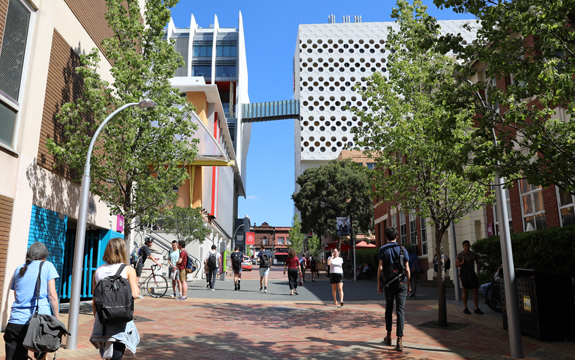Swinburne’s new academic schools structure designed to power Horizon 2025 strategy

Students and academics will benefit from the new academic school structure
In summary
- The new schools structure aligns the university's academic activity around six schools and the new Horizon 2025 strategy.
- Students and academics will benefit from an improved configuring of complementary disciplines.
- Swinburne took an open and collaborative approach to design the new structure for academic advantage and growth.
Swinburne University of Technology’s new schools structure becomes effective today, aligning the university’s academic activity around six schools and the new Horizon 2025 strategy.
“Our new academic structure means that we are more aligned to Swinburne’s strategic purpose of bringing people and technology together to build a better world,” Professor Chris Pilgrim, Deputy Vice-Chancellor (Academic) – Interim, said.
“Students and academics alike will benefit from this improved configuring of complementary disciplines to achieve academic advantage and growth,” he said.
Swinburne’s six higher education schools are now:
- School of Business, Law and Entrepreneurship, led by Professor Keryn Chalmers
- School of Design and Architecture, led by Professor Jane Burry
- School of Engineering, led by Professor Emad Gad
- School of Social Sciences, Media, Film and Education, led by Professor Mia Lindgren
- School of Health Sciences, led by Professor Bruce Thompson
- School of Science, Computing and Engineering Technologies, led by Professor Alex Stojcevski
Professor Mirko Bagaric will continue to lead the Swinburne Law School, which now becomes part of the School of Business, Law and Entrepreneurship.
As previously announced, Professor Virginia Kilborn will officially step into her new role as the inaugural Swinburne Chief Scientist.
“Swinburne’s open and collaborative approach to this design ensures that we are focused on delivering what’s best for our students and providing an environment for them to thrive,” Professor Pilgrim said.
“We are committed to providing opportunities for our students, such as work integrated learning, that will ensure that the university experience is an enriching one and offers real world opportunities.
“Current and new students can feel confident that Swinburne’s schools and courses will be the best available to help them build their new career, now,” he said.
-
Media Enquiries
Related articles
-

- University
The future of fashion: Swinburne launches groundbreaking tech-focused fashion course
Swinburne University of Technology is fusing high tech and high fashion to launch a new forward-thinking Bachelor of Design (Fashion).
Thursday 25 July 2024 -

- University
Swinburne achieves first Cygnet Award through SAGE Athena Swan program
Swinburne has achieved its first Science in Australia Gender Equity (SAGE) Athena Swan Cygnet Award.
Monday 01 July 2024 -

- University
Future of National Institute of Circus Arts (NICA) secured
NICA will transition from Swinburne to the Australian College of the Arts (Collarts), as part of a new agreement that secures the future of circus arts in Australia.
Monday 22 July 2024 -

- University
Swinburne among world’s top 15 universities for scientific impact
Swinburne has been ranked in the top 15 universities in the world for scientific impact across all disciplines, based on the proportion of a university’s papers that belong to the top 1 per cent most cited in the 2024 CWTS Leiden Rankings.
Friday 19 July 2024 -

- University
Opinion: The missed opportunity in the Australian Universities Accord
The Federal Government’s announcement of the Australian Universities Accord Implementation Advisory Committee is welcome, but the glaring omission of dual sector representation is a missed opportunity.
Monday 17 June 2024

